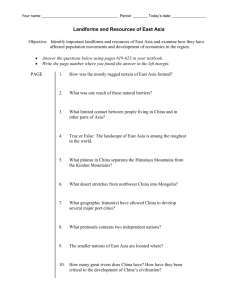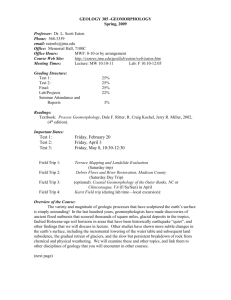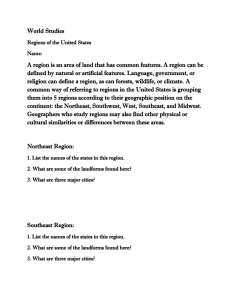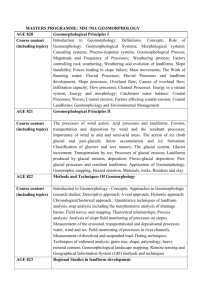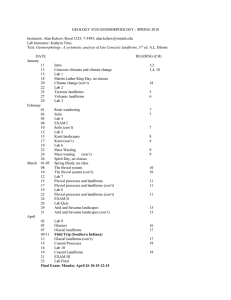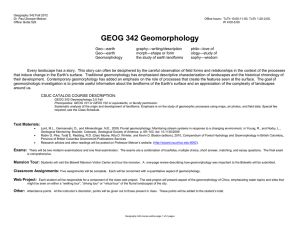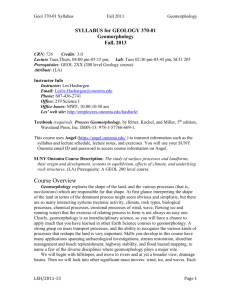Global Warming
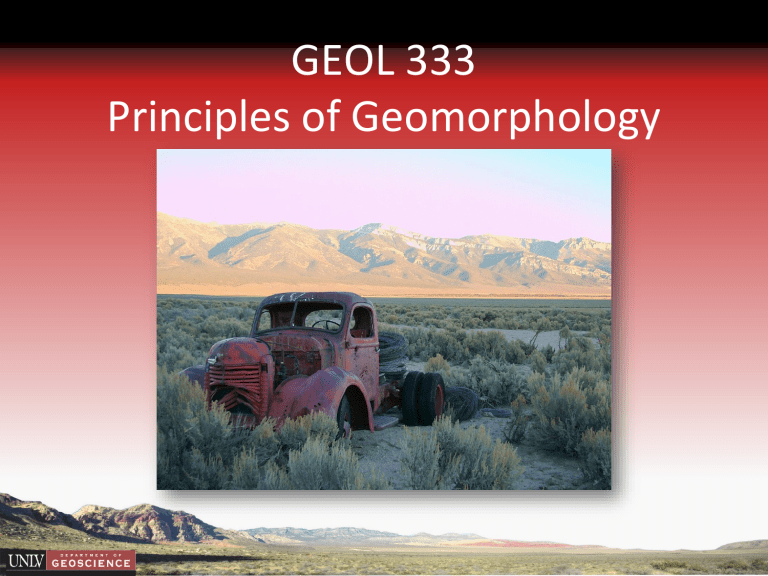
GEOL 333
Principles of Geomorphology
Goals of this class
• Read landforms from topographic maps and aerial stereophotos
• Identify and describe landforms
• Discourse upon landform origin
What do you need to know for exams?
• Textbook chapters are the information source of reference for exams
• Lecture is only a guide
• Plan at 2-4 hours of reading time per chapter
Chemical Weathering and Soils
Physical Weathering and mass movement
Drainage Basins and Fluvial Processes
Fluvial Landforms
Eolian and Arid land geomorphology
Glaciers and glacial mechanics
Aletsch Glacier, Switzerland (Lachniet, 2011)
Glacial erosion and landforms
Karst Processes and Landforms
Coastal Geomorphology
What is Geomorphology?
• The study of LANDFORMS
– 1) Form
– 2) Process
• Theoretical
• Experimental
• Descriptive
– 3) Geology and Climate (Physical)
– 4) Geography (Spatial)
– 5) History (Temporal)
Basic Principles of Process
Geomorphology
• An equilibrium (“delicate balance”) exists between landforms and processes
• Balance between form and process created by interaction of force and resistance
– Driving Forces and Resisting Forces
• A coastal bluff in California is stable only if the driving forces
(gravity, weight of sediments) is less than the resisting force
(friction between particles and cohesion)
• Heavy rainfall on coastal bluff increases water table (adding weight), and decreases the cohesion of the sediment, and becomes a landslide (temporary disequilibrium)
• The new slope has adjusted to be closer to equilibrium
• Example of Coastal
Bluff
La Conchita, California
Ca. 1995 Ca. 2005
Endogenic and Exogenic processes
• Endogenic processes – energy source is internal, i.e. within the Earth
– Volcanism
– Orogeny and Tectonics
• Exogenic processes – energy source is external
– Gravity
– Sun
• Solar constant of 2.0 cal/cm 2 /min
– Climate
• The average of weather over 30+ yr
• Both combine to produce landforms
Volcan Popocatéptl
Volcanism – composite volcano
Angle of repose
Gravity
Age
Volcan Iztaccíhuatl, Mexico
Volcanism – composite volcano
Temperature
Precipitation
Glaciation
Gravity
Thresholds and Equilibrium
• Thresholds represent the limits of equilibrium
• Can be measured
– E.g. increasing slope angle, water content, and landsliding
• An extrinsic threshold is where the threshold is crossed by exogenic processes
– increased rainfall on a slope already near failure
• An intrinsic threshold is crossed when endogenic processes result in a decrease in resisting forces
– weathering of cements that bind grains together
Example of threshold response
Gullying in the Scottish highlands; Lachniet, 2001
Driving Forces
• Solar Radiation
• Insolation – amount of energy absorbed by the system
• The sun drives the climate system
• Main energy source for exogenic processes
Global Circulation
Precipitation vs. latitude
Figure 1-5
Driving Forces
• Gravity
• Equal over surface of earth
• Controls processes such as fluvial action, glacial flow, tides
• Internal Heat
Driving Forces
• Radioactive decay
• Less than solar radiation heat
• Causes uplift and deformation
Resisting Framework
• Lithology and Structure
• Silicic and mafic
• Igneous, metamorphic, sedimentary
(consolidated and unconsolidated)
• Variations in weathering due to climate and mineralogy
• Faults, folds, mountains, basins
• Stratigraphic variations in rock density
Complex Response and Process Linkage
• Threshold-crossing events initiate sequence of changes
• Process Linkage
– “Cascading” effects in geomorphic system
• Hydraulic mining in Sierra Nevada
– Increased sediment loads
– Bed aggradation
– Slope steepening
– Increased flooding
– Gradual relaxation to original state (unfinished)
• “Recovery time”: time to revert to original state
Feedbacks
• Positive
– Reinforcing
– “Snowball” effect
– Not judgmental!
– Uplift erosion overburden removal uplift
• Negative
– Dampening
– Thermostat
– Flood scouring of stream channel wider x-sectional area
slower stream velocity more sediment aggradation
smaller x-sectional area
Next Topic: Internal Forces and
Climate
• Read Chapter 2.


